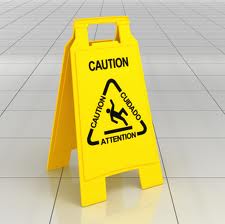
9:01 AM, 28th March 2013, About 11 years ago 4
Text Size
 A Simple Landlords guide to Health and Safety written by Syd Lewis
A Simple Landlords guide to Health and Safety written by Syd Lewis
When I first started renting properties some 20 years ago, to be legal, all you had to do was have a rent book and if you wanted to ensure you could get possession of your property at the end of the tenancy you drew up an AST. It seems these days Landlords are required to perform more and more tasks, which has not only resulted in having to spend additional time managing their properties but also increased cost. In my work as a professional inventory clerk, I often meet new property owners who apart from perhaps having some vague idea that they need a gas safe certificate and an inventory as part of the Tenancy Deposit Scheme know of little else. This article is for them just to give a few pointers in plain English about some other aspects to consider about health and safety when letting a property.
First the stick, penalties and enforcement, if you for whatever reason, fail to comply with any of the statutory regulations for Landlords and rented property you could be fined up to £5000 or even receive a custodial sentence. Further, if you need to make a claim on your insurance and you are in breach of the regulations your insurance is likely to be void.
Now the Carrot, in my years as a Landlord one of my great pleasures it to hear my tenants tell others that I am a good Landlord and how they like living at their rented home. Apart from the obvious ego massage, there are other benefits, they stay longer at the property reducing void periods and the hassle of finding, vetting and establishing a new landlord and tenant relationship, they tend to take greater care of the property and are willing to pay a higher market rent the live there.
First and foremost, it is the landlords responsibility the make sure the property they let is habitable, in health and safety terms, adequate heating and ventilation, lighting, proper sanitation and more recently good insulation. It is also important for Landlords to make sure tenants understand their responsibility too. I have found a great aid to this, is not just to tell tenants what to do but also to provide a “tenant’s pack”. This includes a welcome note, important information, e.g. how to turn off the water in an emergency, what they should do if there is a problem with the boiler, how to properly ventilate and look after the property to avoid excessive condensation and the resultant mould, operation manuals for any appliances at the property. As a matter of thoroughness, I also recommend that you have copies of any certificates for the property in the tenants pack even if you are not required by law to do so.
INSULATION
Energy Performance Certificate (EPC):
EPC, is a document that states the energy efficiency of a property in bands such as A.B,C, D, etc. stating its typical energy use for the year and estimated cost. The certificate is valid for 10 years. You are required to provide a copy of an EPC to any new tenant. If it is in your tenants pack, you have fulfilled your duty.
FIRE
Furniture and Furnishing Fire Safety Regulations (FFL):
Since 1997 all upholstered furnishings must be fire resistance and have the appropriate fixed permanent labels attached: Beds (including headboards, bases and mattresses), sofa-beds, futons and other convertibles, children’s furniture, garden furniture that can be used in the dwelling, scatter cushions, seat pads, pillows. This is not normally an issue these days as most modern furniture is already labelled. However, should the label come loose or be taken off then you will be in breach of the regulations. A good inventory will list each item that has a FFL and help identify any such items that may have had their label removed or damaged during a tenancy.
Fire Extinguishers and Blankets:
There is no compulsory requirement to provide fire extinguishers or fire blankets in single occupation tenanted properties (please note there are special regulations for HMOs and converted building over two stories), but again, this may be a wise precaution, at least in the kitchen area. Having made the decision to provide fire extinguishers, the landlord or agent must then arrange for regular servicing – usually on a 12 monthly basis. You will need to keep up to date records and keep a copy in tenants pack.
Smoke Detectors:
Since 1992 it is required that, all smoke alarms are electrical mains supplied and have a battery backup. There are specific requirements as to which type and where they should be place according the buildings structure and layout. It is the landlord’s duty to make sure the correct devices are fitted at the correct location and to ensure that all devices are working properly when a new tenant takes up occupancy. Thereafter, it is the tenant’s responsibility to regularly check the device by looking for the green light, pressing the self-test button to ensure it is working and when necessary change batteries. Cleaning should be carried out by a competent person and manufactures instructions should be followed. The Landlord needs to make sure that the tenant is aware of their duty and it is a good idea to have this in writing and ensure that there is operation and cleaning advice in the tenants pack.
GAS
Gas Safe:
Landlords are required by law to have an annual gas inspection on all internal gas installations, this must be carried out by a registered Gas Safe Engineer who will upon passing the gas appliances as safe, issue a Gas Safe Certificate. You must ensure that you provide a copy of the certificate to your tenant. If it is in your tenants pack, you have fulfilled your duty.
Carbone Monoxide Detectors:
There is no legal requirement for Landlords to fit Co2 alarms. However, it is a good idea to have them, the principles to follow are those used for a smoke detector. They should be fitted 1m from the boiler and manufactures operating instructions put in the tenants pack.
ELECTRICAL
Periodic Electrical Testing:
If a property is a new build then it should have a “Domestic Electrical Installation Periodic Report” which states the electrical system is safe to use, if not then the property is not habitable. All electrical systems deteriorate over time, the Electrical Safety Council recommend that a periodic electrical test be carried out on rented property every 5 years, a suitability qualified electrician must carry this out. You should keep a copy in your tenant’s pack.
Portable Appliance Testing (PAT):
There is no direct statutory obligation on Landlords or agents to have PAT checks carried out on the electrical system or appliances. However, under the Electrical Equipment (Safety) Regulations 1994, the Plugs and Sockets etc. (Safety) Regulations 1994, both of which come under the Consumer Protection Act 1987, there is an obligation to ensure that all electrical equipment is safe. Also by having regular tests carried out it is a landlords best defence against negligence and acts as corroborative proof that an electrical item was working/ undamaged at the beginning of a tenancy or during a deposit dispute. A copy of the PAT report should be kept in the tenancy pack.
BIOLOGICAL
Legionnaires Disease:
Legionella are bacteria common in artificial water systems such as storage tanks, pipework, taps and showers. People can catch the disease if they inhale into their lungs tiny water or vapour droplets carrying the bacteria. Different properties will require differing approaches – a new build property with a combi-boiler presents less risk than a Victorian terrace with an old water system. If you think, you may have an issue you can go to HSE website and read their free booklet on risk assessment. Upon having completed your risk assessment, if there is no need for further action simply keep a record that no action is required.
Damp and Mould:
Is usually caused by excessive condensation and in most cases can be attributed to the tenant, but not always. Landlords need to be aware that under Healthy Housing and Safety Risk Scheme 2006, Local Authorities can serve you with an improvement notice and fine you. The best protection against this is to have conducted an assessment for condensation and ensure that the property has adequate heating and ventilation. You should also provide your tenant with appropriate instructions on how to avoid and control condensation.
Pets:
The issue here are fleas and potential new tenant’s allergic reaction to an active protein in the salver of a cat. The simplest, measure I have found is to have agreed with the pet owning tenant that they will pay for a professional clean at the end of the tenancy. It is also important to establish the level and quality of the clean required.
Vermin and insects:
Regardless of who is at fault, if a property becomes infested with insects and or vermin, it is always in the Landlords best interest to get it sorted out quickly and by a professional. You can sort out who pays afterwards; fact is if the tenant refuses to pay, you would need to get it sorted anyway.

Syd Lewis has been a private landlord for over 20 years, he is an accredited member of the National Landlords Association (NLA), Residential Landlords Association (RLA), Sponsor of the Good Landlords Campaign, a full member of the Association of Professional Inventory Providers (APIP) and a Certified Electrical Portable Appliance Tester (NIPIT). He is passionate about what he does which is providing residential inventory services, PAT testing and marketing floor plans for Agents, Landlords and Tenants. Inventories start from £56.00 to find out more see:-
Previous Article
NLA report void periods on steady decline
10:33 AM, 29th March 2013, About 11 years ago
I have been a landlord for about 29 years,and found this article most interesting,particularly the advice on what to put in a tenant's pack.
14:16 PM, 29th March 2013, About 11 years ago
Hi syd
I am not a landlord as yet , however do aspire to be one soon at the moment I am in the process of reading and learning everything I can about property. I just wanted to commend you on your article as I found it was one of the most informative to date that I have read.
Regards Stephen
Joe Bloggs
10:43 AM, 30th March 2013, About 11 years ago
syd
you state 'Since 1992 it is required that, all smoke alarms are electrical mains supplied and have a battery backup'.
under what enactment is that?
also you state 'Carbone (sic) Monoxide Detectors should be fitted 1m from boilers'. this is not necessarily the case at all and it is vital to follow the instructions for each alarm!
23:46 PM, 30th March 2013, About 11 years ago
Great article.
Just wondering what happens if the fire saftey label does get pulled off of furniture? Does it have to be replaced just because the label's missing?